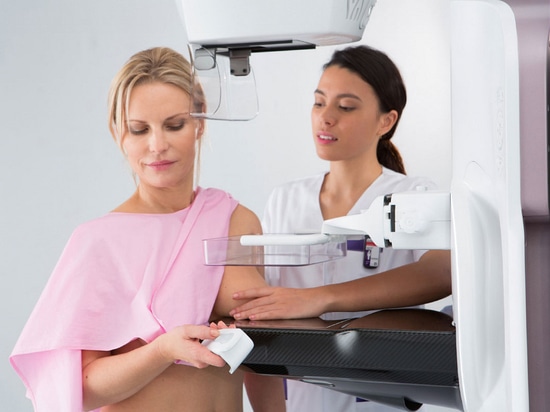
#Product Trends
The First Isodose Sonographer
Thanks to the acquisition of General Electric’s Pristina 3D sonographer, the breast clinic of the CHIREC hospital in Brussels has just completed the first biopsy under isodose tomosynthesis.
A machine, a concept and technology that is revolutionizing the detection and diagnosis of breast cancer. We interviewed Dr. Veronica Mendez, the semiologist who performed this groundbreaking biopsy last October.
MedicalExpo e-magazine: Are you satisfied with the first uses of this high-tech machine?
Dr. Veronica Mendez: Absolutely. Since the beginning, I’ve been using the Pristina 3D with a lot of satisfaction. This high-tech General Electric sonographer uses the latest high spatial resolution medical imaging system: the digital tomosynthesis. It allows you to visualize in 3D anomalies that couldn’t be detected with the other technologies but also to visualize with much more precision the anomalies already detected. And since the Pristina 3D also allows you to perform a biopsy under radiological control, we can achieve both accurate targeting of an anomaly and also acquire tissue samples with absolutely certain accuracy and reliability.
It allows you to visualize in 3D anomalies that cannot be visualized with the other technologies but also to visualize with much more precision the anomalies already detected.”
MedicalExpo e-magazine: Does this machine and its technology change your work?
Dr. Veronica Mendez: Compared to the old modalities, some gestures are removed which saves a lot of time, but especially now we get a lot more shots in really incredible quality. In fact, while before we were operating to find out what something was, today we operate already knowing what it is. It’s very different. We can make reliable therapeutic suggestions. We can therefore identify the anomaly, define a territory of intervention and even determine a surgical procedure. It’s a real revolution.
MedicalExpo e-magazine: Is it also a revolution for the patients?
Dr. Veronica Mendez: The whole machine has been designed to be more pleasant, for example in the case of the curvatures of the compression pallets. Women are very often traumatized because of the compression of the breast, but here everything is done smoothly and is adapted to the anatomy of the patient. What’s even better is that GE designed a system of self-compression that the patient can control on their own with a joystick. It is therefore the patient who is the actor of their examination. In addition, GE is also developing “Sensory suites”—decorated and comfortable rooms using senses like smell, sight and hearing to reduce the discomfort and the anxiety of the patient.
Women are very often traumatized because of the compression of the breast, but here everything is done smoothly and is adapted to the anatomy of the patient. GE designed a system of self-compression that the patient can control on their own with a joystick.”
MedicalExpo e-magazine: Yet today other sonographs also allow you to perform biopsies under tomosynthesis, what makes the Pristina 3D unique?
Dr. Veronica Mendez: What makes the machine developed by GE unique is really its “isodose” label. This means that we have a better image quality but also much more images with a limited amount of X-rays. This is the major technological advance of this machine. And this concept made GE stand out from other companies because their machine came on the market when more and more patients were worried about the amount of radiation dispensed in order to get an accurate diagnosis. With the Pristina 3D they benefit from an optimal benefit/risk ratio.






